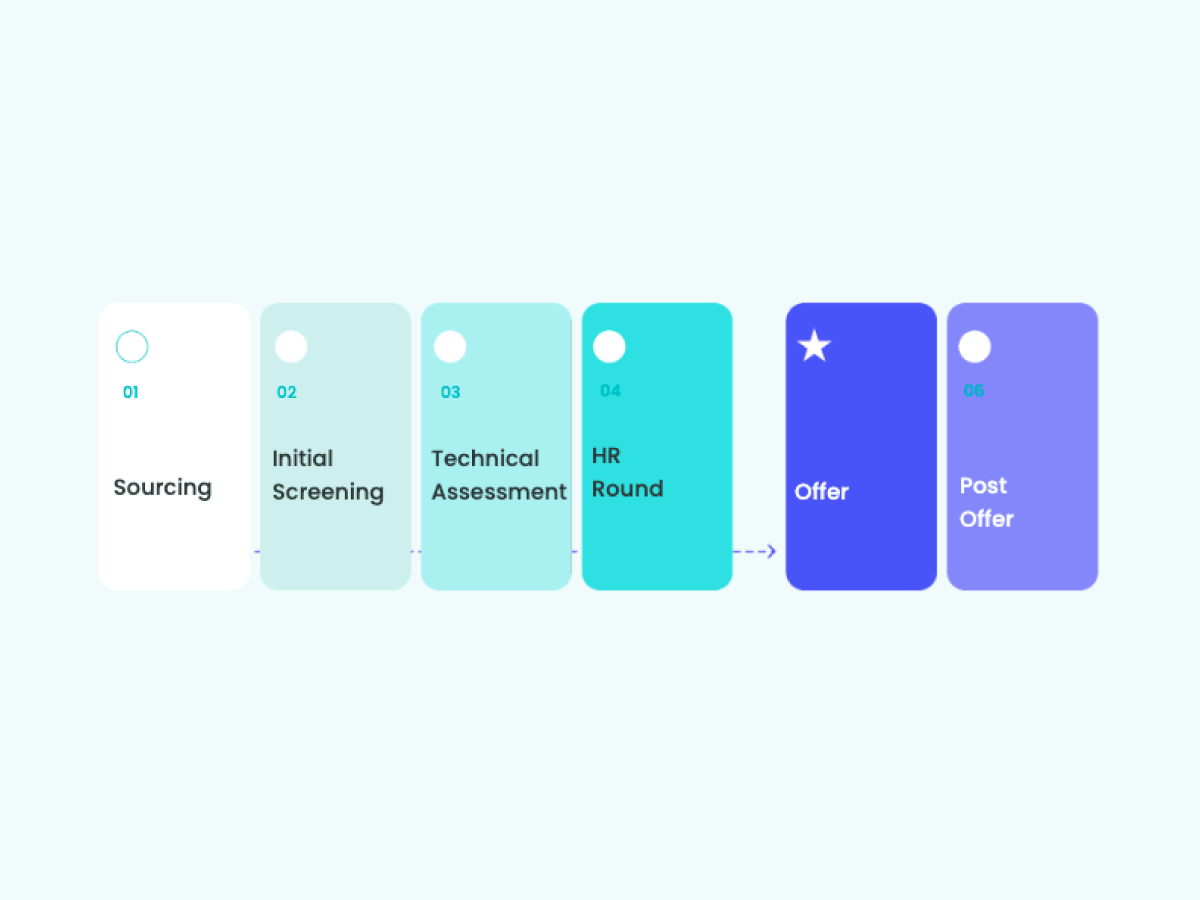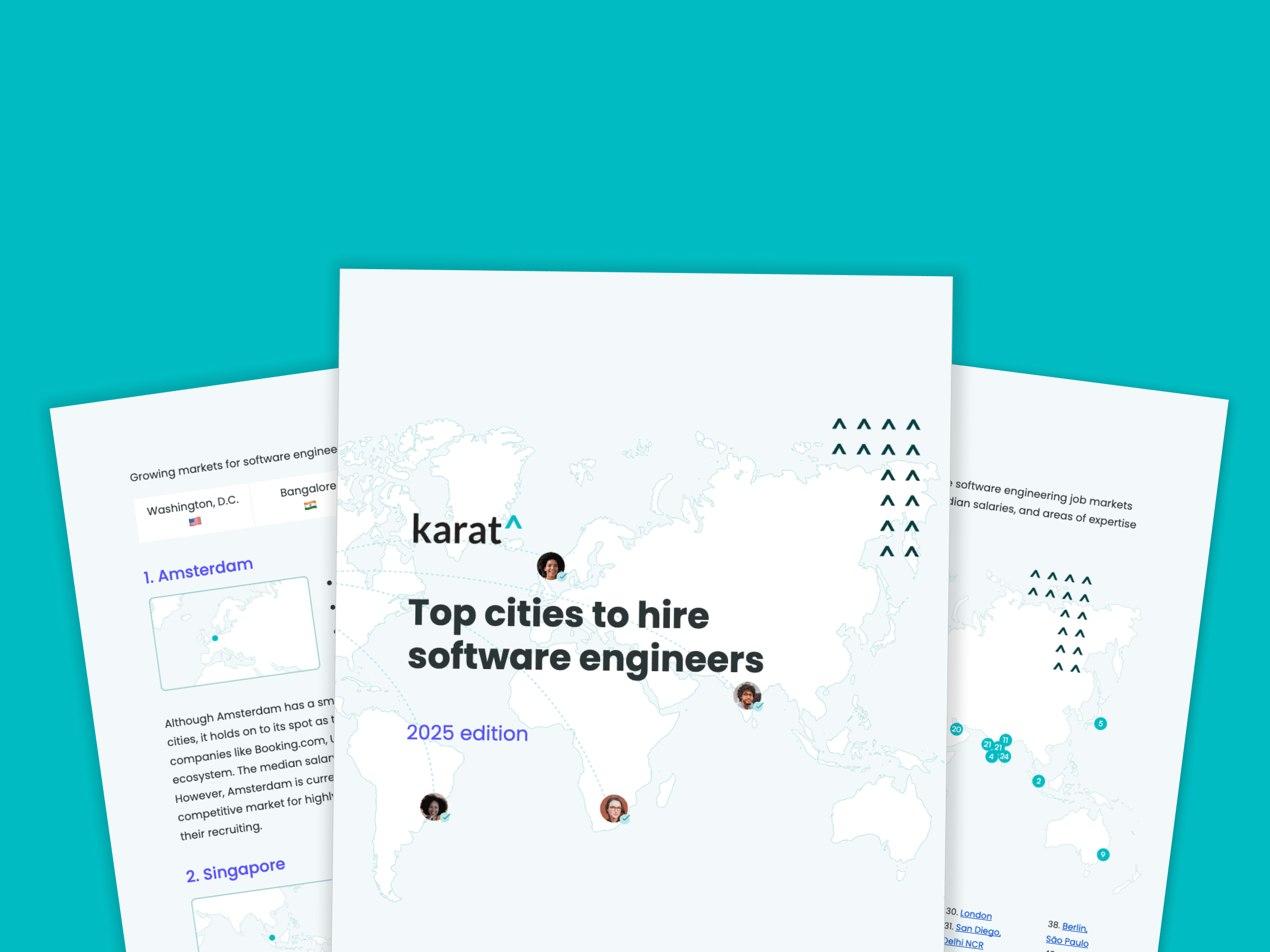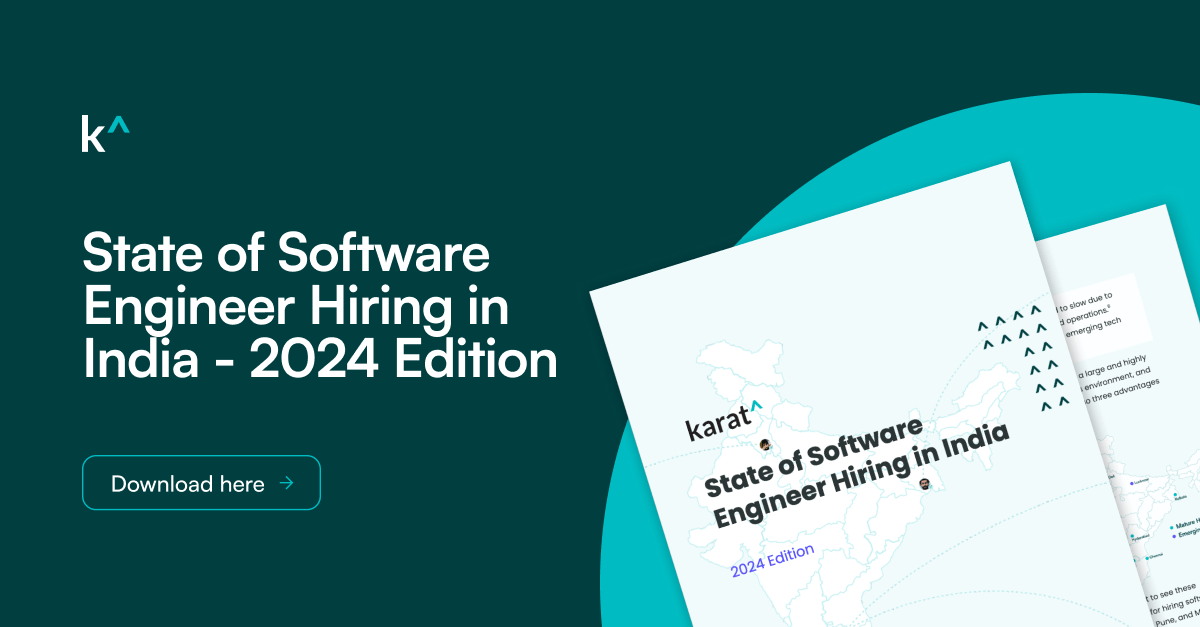Global Hiring
02.13.2024
The Engineering Hiring Funnel in India

Veronica French


Speed to offer is critical in India’s competitive engineer hiring market, but the active hiring funnel is filled with inefficiencies that lead to delays. Here’s a look at the steps in the hiring funnel and what each step typically involves.

Sourcing
Methods for sourcing candidates in India are similar to the U.S. Companies use the following methods:
The most significant difference between sourcing in the U.S. and India is the number of applications. There are many more candidates and applications to go through in India, as India has nearly 5 million software engineers while the U.S. has 4.4 million.
In addition, candidates from top-tier colleges often get preferential treatment. Colleges in India are ranked from Tier 1 to Tier 3, and preferential recruitment is given to the top-tier colleges. Rankings are subjective to each company, so while a college may be classified as Tier 1 with one company, it may be considered to be Tier 2 to another company.

While many organizations give preferential recruitment to higher-tier universities, the reality is that using adaptive skills assessments to identify and prioritize top candidates early in the hiring process is a more predictive indicator of hiring success.
By prioritizing candidates with strong skills, whether earned through innate abilities, college, or training institutes, hiring leaders can get ahead of the competition and increase hiring efficiency by identifying talent others might overlook if they didn’t graduate from a Tier 1 college.
Why is this? Candidates want quick, easy, and informative processes. When the application is complex, has too many steps, or takes too long to complete, candidates simply leave. For example, it takes an average of 51 clicks to get through an application and some applications require candidates to authenticate their identity via email before they can continue. In addition, an astounding 92% of candidates never complete the application process.
A high drop-off rate drives up your cost per hire, increases time to fill, and hurts your quality of hire. Companies can’t afford to have high abandonment rates, especially when speed to hire is critical in such a competitive market. To solve this, it’s important for companies to track their applicant drop-off rate, experience their own application process, and note areas to improve.
Screening candidates is the toughest part of the hiring funnel, and it’s compounded in India due to the enormous quantity of applicants. Each tech job usually receives anywhere from 300 to 1,000+ applications, which easily overwhelms recruiters. Candidates even go a step further and try connecting directly with the recruiter through emails and LinkedIn. It’s very easy to lose out on quality candidates during the sourcing phase for these reasons.
When you factor in additional considerations, such as diversity, niche skill sets, and job experience, the challenge to find the right candidate increases exponentially. It’s like finding a needle in a haystack.
Initial Screening
For many, resumes are the primary source of truth when hiring in India. When there are thousands of resumes for every role, companies need to quickly sift through all of them.
If candidates don’t have a good resume, they don’t stand a chance at this stage because 75% of resumes are never read by a human. Resumes first pass through an applicant tracking system (ATS) before they even reach recruiters. The ATS identifies resumes that contain certain keywords and filters out the rest. Then, recruiters determine who to reach out to solely based on their resume.
This represents a significant inefficiency for hiring leaders, and many organizations are moving towards skills-based assessments to replace outdated resume screening methods. More modern organizations are replacing the traditional resume screen with adaptive assessments whereby questions adjust in real-time to generate a more nuanced signal, similar to the GMAT or GRE. Evaluating skills, not resumes, breaks the cycle of pedigree bias by giving everyone an equal opportunity to showcase their abilities making the evaluations both candidate-friendly and more predictive.
For candidates who are shortlisted, recruiters do an initial 20- to 30-minute phone screening with them where they discuss the candidate’s past experiences, the requirements of the job, and the last drawn salary.
Recruiters are given a compensation range by the hiring manager and senior team. This lets hiring teams in India operate on their own terms — unlike in the U.S., where Finance has a large influence in the hiring outcome because they set the budget for each role. When screening candidates, recruiters ask candidates what their current salary is and see if that works with the budgeted salary. Candidates with salaries fitting within the approved range are taken through the interview process. And only in the final interview is the salary on offer shared. Companies typically offer a 20 – 30% increase to the candidate’s last drawn salary based on their skills.
Because of budget limitations, companies can miss out on good talent. For companies that are entering India, offering a competitive salary, being willing to offer more than the market for the right candidate, and introducing their salary range early on in the interview can all lead to a better candidate experience.
After a candidate passes the initial screening, they’ll receive an online take-home assignment as the first technical aptitude test. Although companies say that it’ll take 8 hours to complete, candidates expect to spend much longer than that due to several intrinsic and extrinsic motivators:
- Intrinsic motivators: Candidates want to do the best they can for themselves. They know the assignment will represent their skills, which have to be a match for the role. As a result, they’ll spend extra time to ensure that the test accurately represents them and gives them the best chance of moving forward.
- Extrinsic motivators: Candidates are up against a lot of competition, and they’re very much aware of it. In particular, competition scales in magnitude when applying with brand-name companies. Reputable companies also have more difficult tests that require hyper-threading, knowing specific languages, and being able to demonstrate other role-specific requirements.

The majority of coding assessments test algorithmic skills rather than programming skills, since they represent a computer science problem that doesn’t reflect the work that an engineer would do on a day-to-day basis. Coding tests are also time-consuming, they don’t reflect real-world programming experience, and the automated scoring of code can lead to false rejections. Developers have a strong disdain for coding tests, and our research finds that only about 60% of candidates complete the code test.
These criticisms of coding tests are legitimate, and they present the perfect opportunity for companies to gain a competitive advantage when hiring. When companies show that they have a developer-friendly coding assessment, it can strengthen their employer brand, give candidates a positive impression of your engineering culture, and encourage candidates to spread the word.
Technical Assessment
After passing the take-home assignment, candidates move to the technical assessment quickly. In this stage, they’ll meet with employees at the company who will evaluate whether the candidate has the technical depth and specific skills needed for the role. The technical assessment usually includes 2 to 3 coding rounds. Each round is 45- to 60-minutes and is completed one-on-one with a technical employee. This means that candidates can expect to do 4 to 6 interviews that take anywhere between 3 to 6 or more hours in total.
The technical assessment can take weeks or even months to complete. The interview process for software engineers in India takes an average of 23.3 days, primarily due to company-specific factors such as the number of interview stages and internal policies.
Final follow-up conversations of the technical assessment are only conducted when the hiring team needs more information from the candidate. Most candidates who perform well don’t need this to get a decision after their interview.
Candidates are offered limited transparency throughout the interview process. With the technical assessment taking weeks to complete, candidates are left in the dark as to whether they’re actually performing well. While excellent companies provide candidates with feedback, it is very generic. This presents an opportunity for companies that are breaking into India to differentiate themselves by being more transparent about what to expect throughout the interview process, and also prepare candidates before interviews by providing an agenda, backgrounds and names of their interviewers, and making warm introductions.
HR Round
The HR round is done either before, after, or during the technical assessment. It gives the hiring manager the opportunity to get to know the candidate’s professional aspirations, goals, and vision for their role at the company. Hiring managers want to make sure there’s a culture fit, get a sense of the candidate’s expectations for the role to make sure there’s a match, and get an idea of how long the employee might stay if they accept the offer.
Offer
The offer stage is when salaries are revealed to the candidate. As stated earlier, these range between a hike of 20-30% of the last drawn salary. For the right candidate though, companies are willing to go over their budget and sometimes offer 40-50% too. Candidates that have in-demand skill sets have more leverage to negotiate, regardless of their years of experience.
Also, when candidates have multiple offers, the power shifts and candidates are able to renegotiate. So it is beneficial to introduce the salary range in the beginning to avoid such renegotiations.
Post-Offer
Even after receiving an offer, many candidates continue to job hunt. This is because candidates may not start up until 2 to 3 months after accepting the offer.
In India, employees are expected to give a 2 months’ notice when leaving to ensure successful knowledge transfer and project continuity, provide companies with enough time to find a replacement, and hinder employees from applying to jobs that require a quick start date. While companies have a lengthy notice period, they almost always want new hires to join immediately or within the next 30 days.
With such a long lag between when the contract is signed and the start date, candidates take this opportunity to look for better offers for a number of reasons.
The candidate may discover bad reviews about the company or may be turned off by a negative experience during the hiring process. Our research shows that nearly a third (27%) of interviews in India are rescheduled, and compared to the U.S. and EU, there are twice as many late cancellations. Companies can avoid candidates looking elsewhere by offering the best candidate experience — one that keeps candidates engaged throughout the process, provides candidates with timely responses, moves candidates along the hiring process faster, and provides an exceptional interviewing experience.
Candidates may also accept an offer that’s lower than expected in order to have the security of a job offer before they resign. Lastly, uncertainty in the tech job market has increased after the COVID-19 pandemic and made it more common for offers to be retracted. By continuing their job search, candidates can protect against this.
As a result, many don’t show up on their first day or ghost the company that they initially accepted a role with.
Companies looking to hire in India need to understand the candidate situation and respond accordingly. Many lose top talent because of their stringent joining terms. Exit formalities also need rethinking – companies should make them simple, leaving alumni with a great impression and encouraging them to refer others. Similarly, create flexible notice periods. Reduce the timeline to 30 days max and make exceptions in case employees have immediate offers.

Learn more about India’s engineering talent market with our 2024 report: The State of Software Engineer Hiring 2024. The report unpacks insights into India’s top talent hubs, the unique engineer hiring funnel in India, top challenges you can expect to face and how to solve them.
Related Content

Global Hiring
11.26.2025
The growth of global capability centers (GCCs) in India has exploded over the past few years. Hiring targets for 2024 were more than double that of the U.S., with an average of 790 open roles in India. This represents a 19% year-over-year increase. Real estate is also becoming impossible to find in GCC hubs such […]

Global Hiring
06.18.2025
In Karat’s 2025 analysis of engineering talent hubs, two Polish cities ranked in the top 20 based on engineering quality in technical interviews, Gdańsk (#12) and Warsaw (#20). Both are outperforming many Western European cities on talent quality, operational costs, and hiring velocity. Read on to learn more about the opportunities and challenges facing CIOs setting up engineering operations in Poland.

Global Hiring
03.12.2025
Top Nearshore Software Hubs in Europe and Americas 1. Belgrade, Serbia - ranked #2 in Europe, #9 globally 2. Gdansk, Poland - #3 in Europe, #12 globally 3. Sofia, Bulgaria - #4 in Europe, #18 globally 4. Warsaw, Poland - #5 in Europe, #20 globally 5. Sao Paulo, Brazil - #1 in LATAM, #38 globally
